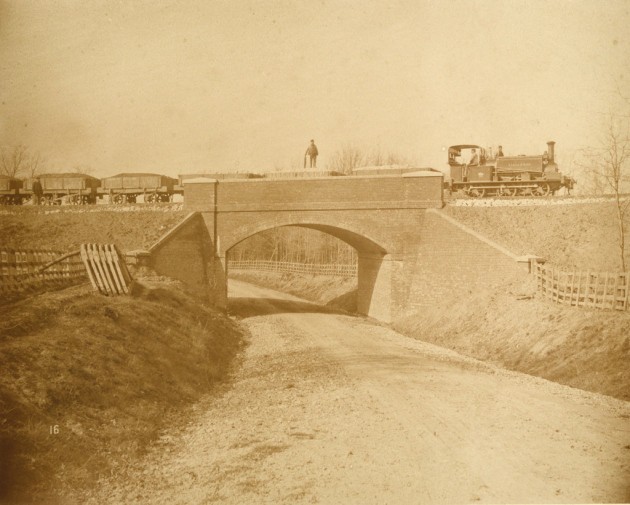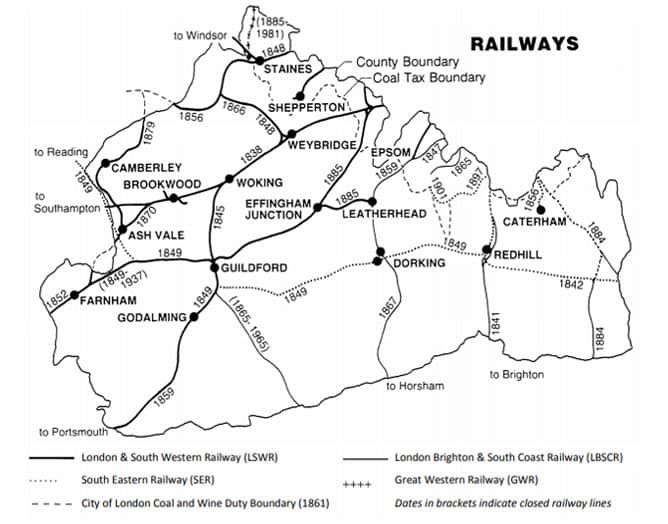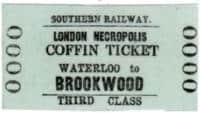Surrey’s Canals and Railways
Prior to Victorian times, waterways and canals had become the preferred method of moving bulk and trade cargoes around the country. The Basingstoke Canal, River Wey Navigations and the Wey & Arun Junction Canal (WAJC) were all busy routes and, indeed, the WAJC reached its peak in 1839 when the canal carried 23,000 tons of goods around Surrey and beyond. However, the 19th century was the era of massive railway growth and, by about 1870 two of the three were effectively dead whilst the River Wey Navigations only limped on into the beginning of the 1900s.
It seems strange to realise that when Victoria became queen in 1837 there were no steam powered railways in Surrey – although the horse-drawn Surrey Iron Railway between Wandsworth, Croydon and Mitcham had opened at the beginning of the century and lasted until 1838.

The basic cause of the demise of the canals was that railways could move larger quantities of material, could travel faster and were not restricted to the availability of water sources. In addition, the promoters of routes soon realised that passenger traffic could be a profitable addition to freight revenues so that it was not long before lines were being created primarily for the carriage of people.
Amongst the first lines to actually open for traffic through Surrey (September 1841) was the London & Brighton Railway. The main trade for this route was the carriage of passengers to Brighton which had become the most popular seaside resort in Britain, with over 2,000 people a week visiting the town.
In May 1845 the first steam train left Guildford for Woking. It only took 12 minutes which is not much longer than the current journey time! Guildford to London took a bit longer but was still less than two hours. Then, in 1849 a link to Farnham was established from Guildford and this was extended in 1852 to become the Alton line. These areas were barley growing districts and a heavy traffic of ale (145,000 barrels) was sent to London. Stone quarries near Alton gave rise to stone being transported widely by rail. Guildford became more important, growing into a railway junction and part of an ambitious scheme to reach the Channel ports from the Midlands and the West.
Many of the companies opening new railway lines across the county and beyond were working independently and there was no agreed gauge for the tracks. In order to create a useful network, they all needed to be standardised and consequently the “Regulation of Gauge Act” was made law in July 1854 to rectify an anomaly of different gauges along the lines.


Another line into Surrey was created by the London Necropolis Company. This company purchased land at Brookwood, near Woking, and created a large cemetery to cater for the needs of London – whose local cemeteries were becoming full.
Brookwood station opened in June 1864 and served special trains consisting of normal coaches for the mourners and special hearse vans for the coffins.
The railway company did well, gaining not only from the journey to the cemetery, but also from subsequent visits by relatives.
The public soon realised that railways provided new ways for them to enjoy their leisure hours with trips to places which had previously been less accessible. Hampton Court was already a popular destination and a branch line from Woking was created for this trade. There was opposition but it was considered a public necessity to provide recreation to the poorer classes. By 1865 as many as 13 of the 47 main line departures from Waterloo were for Hampton Court. In 1861 a line to Richmond and Shepperton had been built so that London workers could escape from the overcrowded and unhealthy portion of the city into the healthier localities. Then in 1867 the station at Boxhill and Westhumble was built and the leisure trade to the area blossomed.
Victorian Surrey was well served by racecourses and the first ideas of reaching Epsom Racecourse came in 1838. Trains were planned on race days and passengers were set down on the Kingston to Epsom line. They then had to journey the last 6 miles on foot or by car or trap. It was clear that a station nearby was required and one was opened on 22 May 1865 just in time for Derby Day.
Woodside station, close to Croydon Racecourse, was opened in 1871. Horses were often brought to the racecourse by train and for a number of years a track to the course from the down side of the station catered for many famous horses. Gatwick Racecourse station on the main London to Brighton line opened in 1891 and to cater for the anticipated traffic, a relief line was opened from Gatwick Racecourse to Horley in October 1892. Meanwhile, Kempton Park racecourse had proposed a station in 1877 but this was rejected. One was built in 1878 with them paying half the costs themselves.
The last of the Surrey racecourse stations to be built takes us back to Epsom. Tattenham Corner station opened in July 1901 and handled around 15,000 passengers. Many came from London but a large number arrived from the coast or through Reading. The punters were taken right to the racecourse itself. In addition to this a raised lawn close to the station gave excellent views over much of the Downs.
And so, from an absence of railways at the beginning of Victoria’s reign, a complex network had been created across the county to support trade, ‘commuter traffic’ to London and provide leisure opportunities for the population of London and the surrounding counties – a legacy which is still with us.
Sall Baring
Acknowledgements
• Map of Victorian railways across Surrey, courtesy of Surrey Industrial History Group
• Photo of train – probably East Clandon Common Bridge over Ripley Road, courtesy of Surrey History Centre



